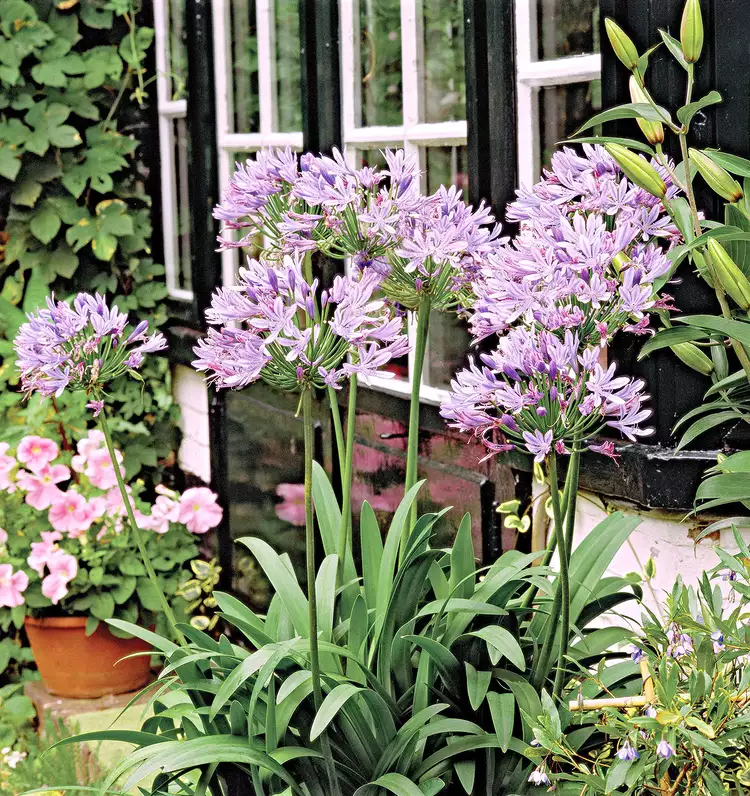Growing conditions can vary greatly depending on your elevation, your location inland or near the coast, and in which of the three sections—northern, central, or southern Florida—you live. These plants grow well in all parts of Florida, Zones 8-10.
Bulb Selections for Florida
Many bulbs, rhizomes, tubers, and corms grow well in Florida. However, gardeners expecting to grow tulips, hyacinths, and some types of irises or lilies will be disappointed, as these bulbs need a cold dormant period. Luckily, Floridians in all areas of the state can enjoy many beautiful bulbous plants year-round that Northerners can only grow during the summer months.
African Lily (Agapanthus africanus) grows strappy green leaves and stately stalks with clusters of blue or white flowers rising up to 3 feet tall. Plant it from October to February, placing the tip of the rhizome just below the surface in full sun to partial shade. Keep it evenly moist during the growing season.
Caladiums' (Caladium selections) dramatic, heart-shaped leaves lend a tropical flair and are a top plant for Florida landscapes and container plantings. Place them in full sun to partial shade. Plant the tubers 2 inches deep from February to May. Search for selections in varying patterns with white, pink, red, or burgundy.
Cannas (Canna selections), are old-fashioned favorites that add height (up to 8 feet) to landscape plantings or containers, are easy to grow, and thrive in heat. Frost can kill cannas to the ground, but in Florida, unlike in Northern climates, the rhizomes will rally to produce more plants. Keep the soil evenly moist and grow in full sun to partial shade.
Other tubers, bulbs, and rhizomes that are top plants for Florida include:
- Amaryllis
- Aztec lily (Sprekelia formosissima)
- Blood lily (Haemanthus multiflorus)
- Crinum (Crinum selections),
- Dahlia (Dahlia selections),
- Elephant's ear (Alocasia, Colocasia, and Xanthosoma spp.),
- Gladiolus (Gladiolus selections),
- Kaffir lily (Clivia miniata),
- Walking iris (Neomarica gracilis),
- Peacock iris (Moraea selections),
- Spider lily (Hymenocallis spp.),
- Watsonia (Watsonia selections),
- Rain lily (Zephyranthes spp.)
Trees and Shrubs for Florida Gardens
Pineapple guava (Acca sellowiana) adds landscape interest with its gray-green leaves and waxy, pink-and-white flowers. It produces an egg-sized, edible fruit that tastes like guava. Grow this small tree, which reaches 8-12 feet tall and wide, in full sun. It's easy to grow, tolerates seacoast salt exposure, and stays evergreen.
Many types of palm trees grow well in Florida, including the saw palmetto (Serenoa repens). This native palm tree, when selected in its silver form, can light up a landscape with cool, silvery-blue fronds. At 6 feet tall and wide, this slow-growing, cold-hardy tree can fit into most landscapes, including salty coastal areas. Grow it in full sun to partial shade.
Firebush (Hamelia patens) draws the eye with its orange-red tubular flowers. It's also a hummingbird and butterfly magnet. A Florida native, this evergreen shrub can reach 10 feet tall and 6 feet wide, but a compact variety can be chosen. The leaves are reddish during much of the year, then fade to green. Its small, juicy berries are green, then turn yellow, red, and finally black. Grow firebush in full sun to partial shade. Once established, it is drought-tolerant.
Other small native Florida trees and shrubs worth investigating include:
- Yucca smalliana
- Coontie (Zamia floridana)
- Gallberry (Ilex glabra)
- Gopher apple (Licania michauxii)
- Spanish bayonet (Yucca aloifolia)
Florida Perennials
Many types of annuals and perennials grow well in Florida, but their performance may not be consistent throughout the year, thanks to temperature fluctuations during both day- and nighttime. When temperatures are too low, many tropical plants won't grow well, and when temperatures are too high, some will fail.
Tough perennials that are top plants for Florida
Autumn fern (Dryopteris erythrosora) is among the many perennial ferns that grow well in Florida. Also called Japanese shield fern, its upright foliage reaches about 2 feet tall and wide. Its foliage is a bronze-copper color in spring when the plant is young, then matures to a dark green. Ferns are critter-resistant and grow best in shade. For best results, keep the soil evenly moist.
Zeezee plant (Zamioculcas zamiifolia) is best known as a houseplant in the north but can be grown as a tropical perennial in Florida. Its virtues abound: It grows slowly, attracts almost no pests, tolerates low-light conditions, and needs little water. The stalks of glossy leaves can reach 4 feet tall and 3 feet wide. Beware: All parts of the plant are poisonous if eaten.




















